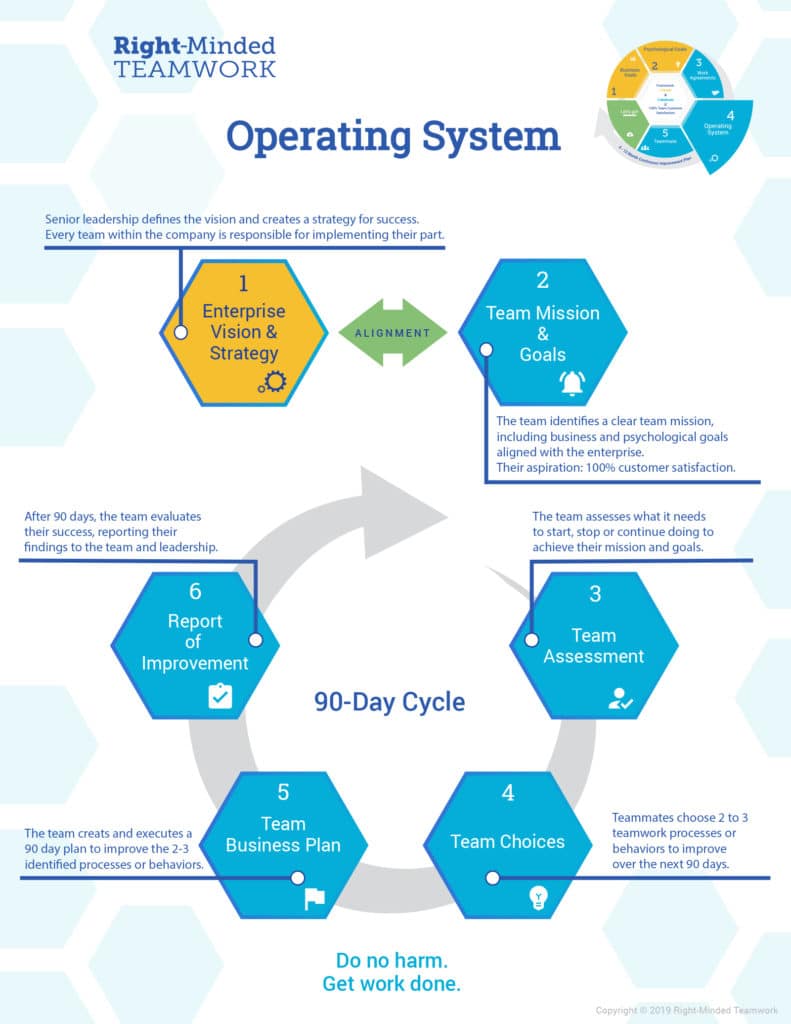Here’s how to improve your team operating system.
To become a high-performing team, one that meets and at times exceeds expectations; you need to apply a continuous improvement team building method. That method will always include a review of your team’s operating system.
Therefore, if you have not reviewed your system lately, your team is not meeting its full potential.
Above all, you are not achieving your customer’s expectations as efficiently and effectively as you could.
In this article, you will learn about how to apply the Right-Minded Teamwork’s Operating System and the 6-step Performance Factor Checklist that is designed to pinpoint your teamwork improvement opportunities.
If you have not looked at how your team operates within the last six months, this article will show you how.
Team Operating System

Whether you realize it or not, your team has an operating system.
Your Team Operating System should properly organize your processes and procedures to ensure you achieve your team’s vision and mission.
To contrast, think of preventive maintenance. If you did NOT stop every so often to tune-up your car, eventually, it will not perform.
Your team is like your car. It is silly to think your team could function effectively without periodic maintenance.
One of the best ways to review and adjust your team’s operating system is to follow the Right-Minded Teamwork’s Operating System process.
This exercise is the 4th Element of the Right-Minded Teamwork’s Framework.
If you are ready, let us briefly review the 6-Step Operating System.
Afterward, we will review a few performance factors from the checklist.
Then we will briefly discuss the three methods for improving your team’s performance.
Overview – How to Review Your Team Operating System
An RMT Team Operating SystemRMT’s Team Operating System is a six-step, 90-day, continuous improvement system that organizes team functions to increase the likelihood of achieving customer satisfaction. More is a 90-day, continuous improvement plan that ensures your team stays focused on achieving 100% customer satisfaction.
In short, your system properly organizes your team processes and procedures.
There are six components in this Operating System.
1 – Enterprise Vision & Strategy
The senior leadership team creates the strategy. Every team within the organization is accountable for implementing their part.
2 – Team Mission & Goals
Once teammates understand their team’s responsibility and accountability, they create a team mission, business goals, and psychological goals.
That is to say, the team’s mission and goals ensure the team focuses its energy and resources on achieving 100% customer satisfaction.
3 – Team Assessment
With clear direction, the team conducts the Team Performance Factor Assessment to determine what the team needs to start, stop, or continue doing to achieve its mission and goals.
The team assessment identifies improvement opportunities. This review ensures the team stays focused and on track. This team assessment is re-administered every quarter, and adjustments are made accordingly.
4 – Team Choices
In this step, teams determine their two to three critical-few projects, deliverables, or initiatives to achieve over the next 90 days.
5 – Team Business Plan
All team choices, especially the two to three critical-few projects, are captured in a Team Business Plan document that will be used to guide and track the team’s efforts over the next 90 days (and every quarter thereafter).
6 – Report of Improvement
Every 90 days, the team conducts another team assessment that calculates actual performance improvement.
Based on assessment results, a Report of Improvement is created and presented to the team’s sponsor or supervisor. In the improvement report, the team also captures key lessons learned as well as their best and worst practices.
If your organization has an RMT Team Management System [TMS], your quarterly Report of Improvement and lessons learned are given to the TMS Leadership Team for company tabulation and knowledge sharing.
Continuous Improvement
Next, the team leader reinforces clarity by confirming its mission and goals align with company-driven objectives. If the team’s objectives align with the company’s objectives, the team repeats the continuous improvement system by examining Team Performance Factor Assessment results, identifying opportunities, and taking action on their findings
25 Team Performance Factor Assessment
In the Right-Minded Team Operating System exercise, you will find 25 Team Performance Factors distributed among the continuous improvement 6 steps. You can find this assessment in our book, Right-Minded Teamwork in Any Team: The Ultimate Team Building Method to Create a Team That Works as One.
Below are a few factors presented as questions.
- Are your organization’s Vision, Mission, and Strategic Objectives clear, understandable, and acceptable to your team?
- Are the organization’s Values clearly stated and embraced by your team?
- Does your team have an engaging vision and mission that lays out a clear road map (team processes) for achieving the team’s Vision and Mission?
- Is there a holistic team assessment process in place that evaluates both team processes and work relationships needed to achieve the team’s Vision & Mission?
- Are all teammates clear about their role, responsibility, and accountability?
- Are your team meetings effective in that they succeed in making certain teammates know and understand what has, what is, and what needs to happen?
- Do you have a continuous-improvement performance tracking system in place?
- Does your team stop periodically to reward legitimate individual and team performance?
3 Methods for Adjusting Your Team Operating System
For those operating system elements that are functioning well, pat yourself on the back. On the other hand, for those elements that need adjustment, you have three strategies for addressing or improving them.
- Improvement Project
- Work Process Agreements
- Work Behavioral Agreements.
Improvement Projects
Some things are not a quick fix, so you need to gather several teammates to implement an Improvement Project.
For example, let us say your team has decided to centralize your teamwork materials and data on Microsoft SharePoint.
Several teammates would be assigned to study the change, determine how and when to go live, and offer teammate training as to how to use the new software.
Outcome: to focus and align teammate work efforts.
Examples of When to Use an Improvement Project.
- Alignment with organizational goals is vague or nonexistent.
- There is a lack of clarity or disagreement about who is doing what.
- Important action items are falling through the cracks.
- There is no clear owner or champion for critical activities.
- Little or no progress is being made on key action items.
Work Process Agreements
Meanwhile, for processes that just need a quick fix, you can create or modify team Work Agreements.
Outcomes: reduce workload, eliminate duplication, add value to team products and services.
Examples of When to Use Work Process Agreements.
- Conflicts or miscommunications occur around roles and responsibilities issues.
- Key processes are cumbersome, time-consuming, reducing productivity, or are inconsistently being followed.
Work Behavioral Agreements
For those times, when the team operating system causes poor teammate behavior, you want to create and follow Work Behavioral Agreements.
Outcome: Improve teammate trust, increase risk-taking, create team loyalty, and accountability.
Use When any of the following is present.
- hurt feelings
- general discord
- cliques
- unhealthy competition
- lack of safety and/or trust
- unspoken anger or resentment
- low team morale
- misguided judgment
- finger-pointing
- criticism
A Little Background on this System
To sum up, this holistic approach evolved to its present state in the early 1990s after our facilitators had worked with 100’s real teams.
That is to say, approximately 80% of these teams were from the manufacturing and electronics industries. Most were white-color knowledge-worker teams.
Above all, a fascinating fact is that approximately 40% of these were self-managing teams. Furthermore, our facilitators continued to work with over 60% of these teams for 2-3 years.
Why was it important to share this?
In conclusion, I wanted you to know that this team operating system came from work-in-the-field. It did not come from a study of articles or books.
Therefore, it is a real-world system that works.
Conclusion
There is no one way to build an effective and efficient team operating system, but these are some of the best practices:
- Stop periodically to look at and adjust your team operating system; we recommend every three months.
- Use the Right-Minded Teamwork – Team Performance Factor Assessment to help you pinpoint your system improvement opportunities.
- Use these three practical strategies to help you improve your team system.
Actions – How to Review Your Team Operating System
Here is an action you can take right now.
Download and begin applying the Team Operating System process as presented in Right-Minded Teamwork in Any Team.
When you purchase the Ebook at our website, you will also receive downloadable Reusable Resouces. Check it out.

To Your Success, Dan




Leave a Reply